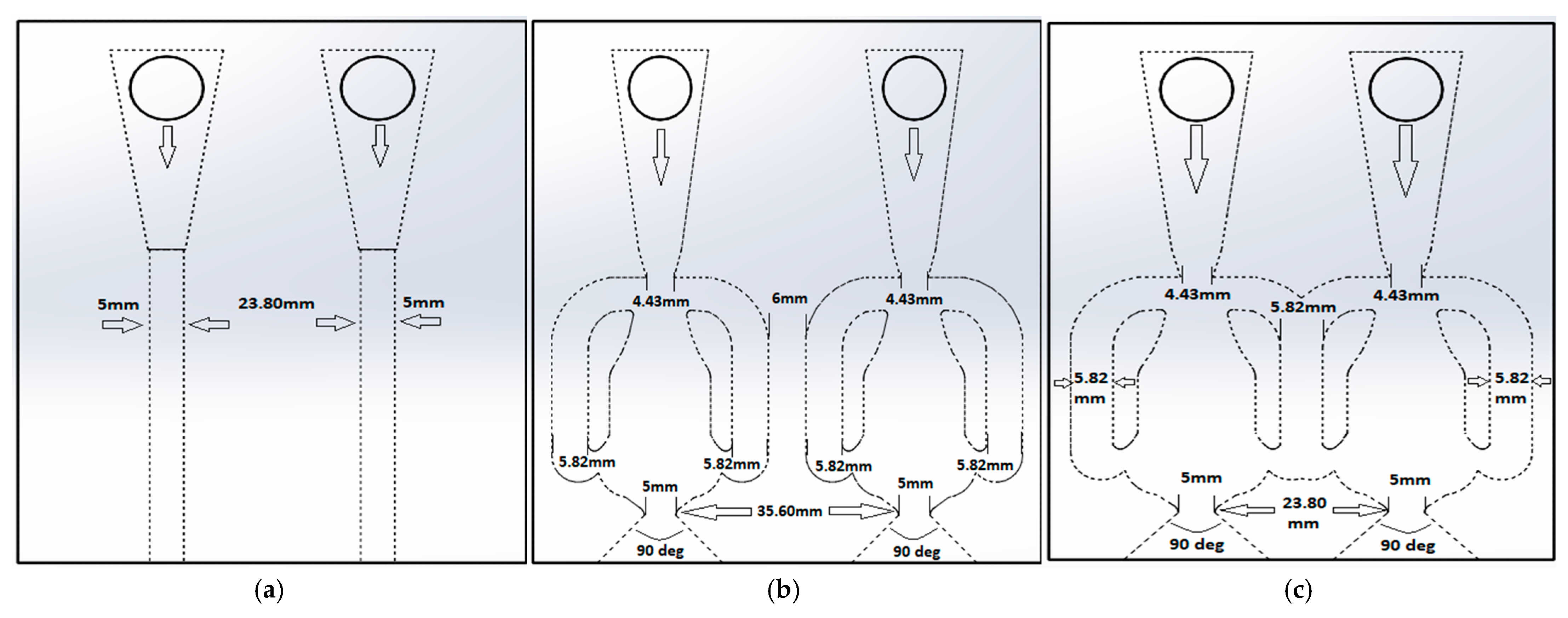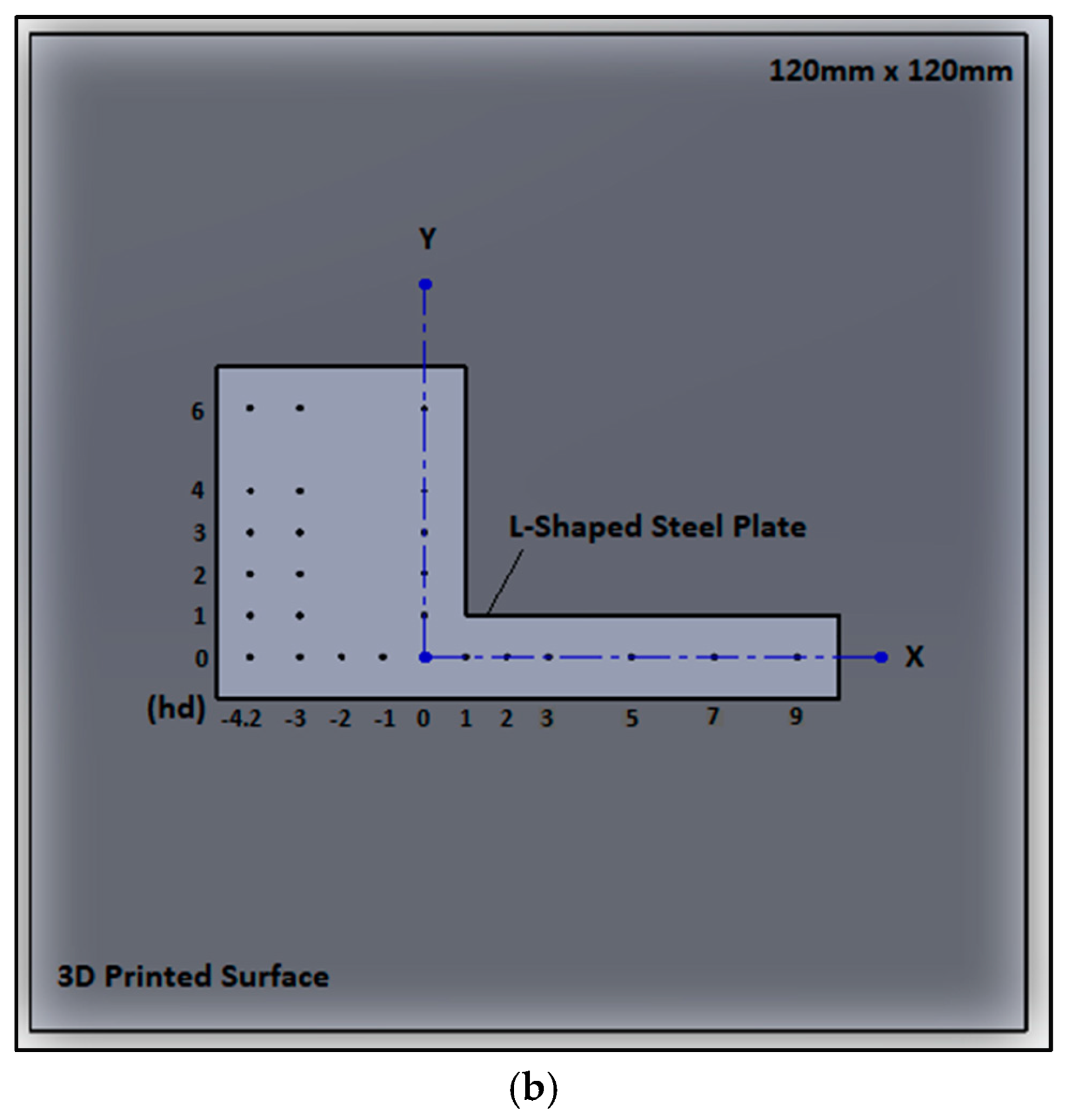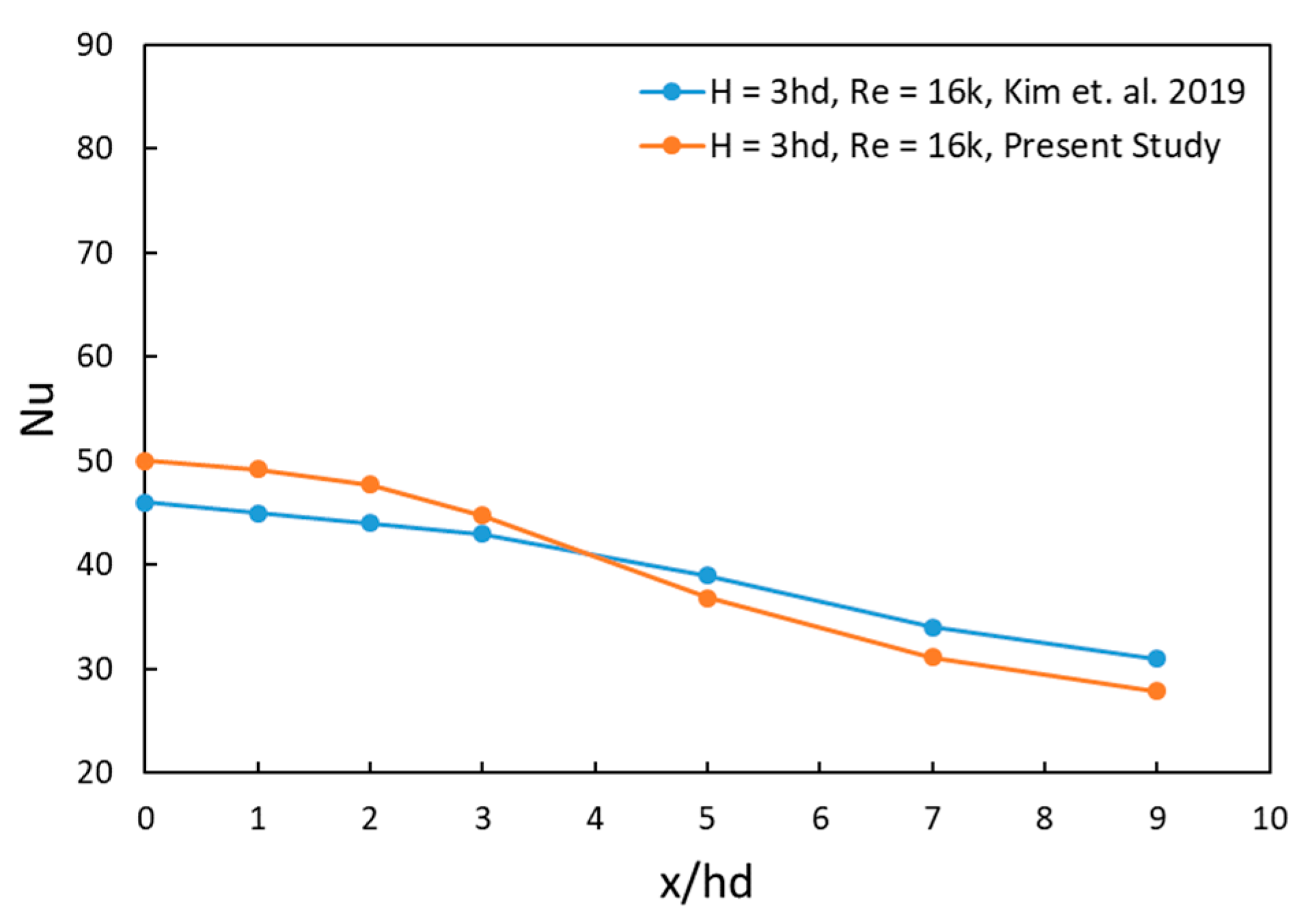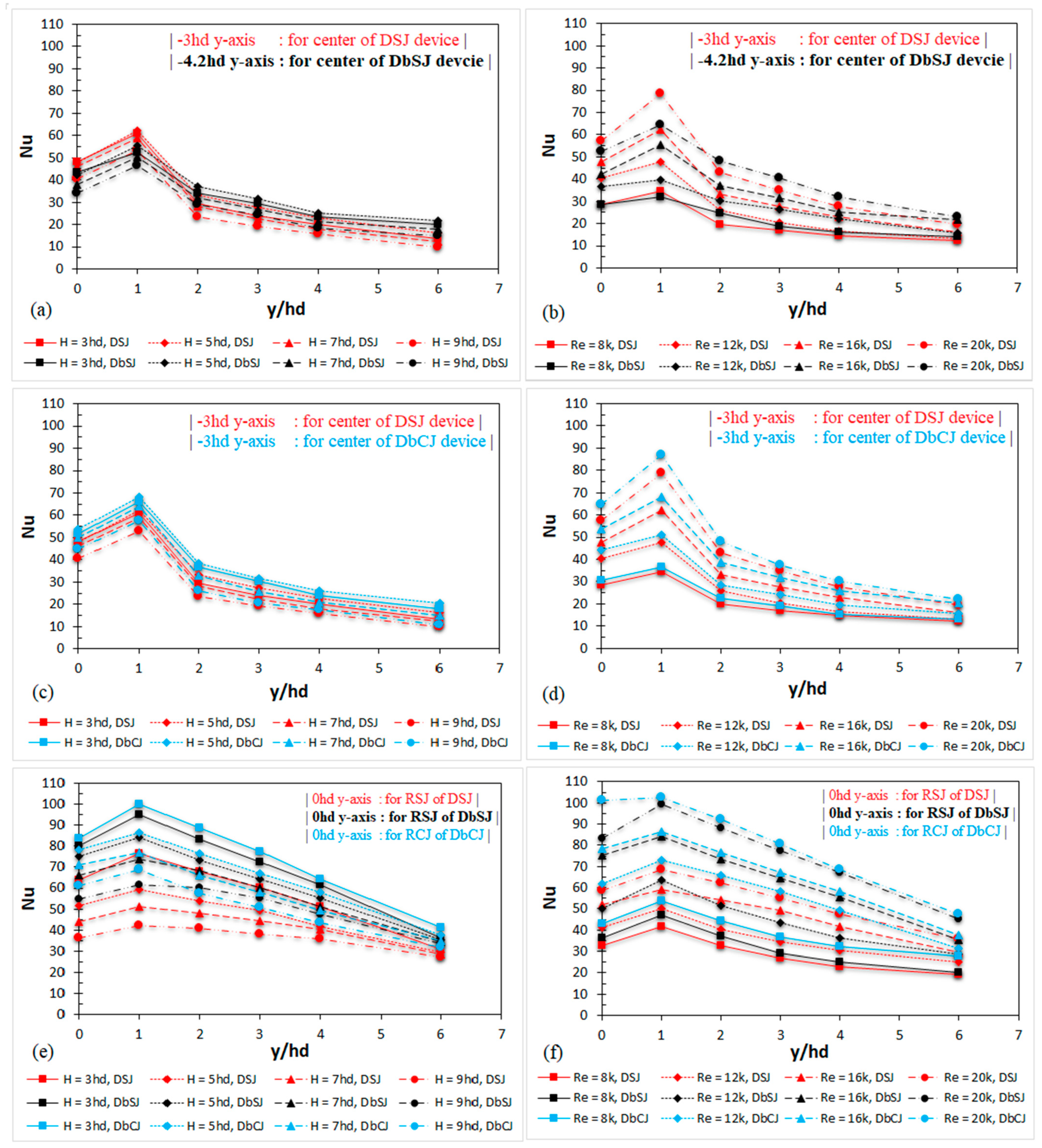Local Heat Transfer Analysis of Dual Sweeping Jet, Double Sweeping Jets, and Double Circular Jets Impinging at a Flat Surface
Abstract
:1. Introduction
2. Experimental Procedure
2.1. Fluidic Devices
2.2. Air-Impingement Setup
2.3. Overall Experimental Setup
2.4. Setup Validation and Experimental Run
3. Results and Discussion
3.1. Fluidic Devices’ Behavior Along the Sweeping Direction
3.1.1. Regional Effects
3.1.2. Effects of Re Number at Various Jet-to-Wall Spacing (H)
3.1.3. Comparison of DSJ, DbSJ and DbCJ
3.1.4. Effects of Jet-to-Wall Spacing (H) at Various Re Numbers
3.2. Fluidic Devices’ Behavior Along the Transverse Direction
3.3. Fluidic Devices’ Behavior at Various Aspect Ratios
3.3.1. Regional Effects
3.3.2. Effects of Re Number and Jet-to-Wall Spacing Variations
3.3.3. Comparison of DSJ vs. DbSJ
3.3.4. Comparison of Aspect Ratios
4. Conclusions
- The Nu number decreased with increasing jet-to-wall spacing and increased with increasing Re numbers for all devices.
- The heat transfer rate is primarily a function of wall local temperature (Tw) and can be represented by the Nu number. Therefore, regions with higher Nu experience a significant drop in local temperature as a result of forced convection between the impinging cool air and heated impinged surface, and vice versa.
- However, the relative comparison showed that DSJ had the best performance at smaller spacing and higher Re, DbSJ had the best performance at moderate spacing and lower Re, and DbCJ had the best performance at moderate spacing and moderate Re.
- The DbCJ is more effective at its core and should be used in industrial applications where the surroundings are well covered by other jets or are of least concern.
- The DbSJ and DSJ are effective in covering larger areas and uniform cooling—especially the DSJ which dominates the area between the two consecutive jets (left region) and outer right region, especially at higher Re numbers.
- The same findings apply to devices with a higher aspect ratio, where DSJ is better than DbSJ in the outer regions. The increase in aspect ratio resulted in the availability of more fluid volume in the outer regions and reduced the difference between the inner and outer regions for all profiles.
Author Contributions
Funding
Data Availability Statement
Conflicts of Interest
Nomenclature and Glossary
| Nomenclature | |||
| A | Area (m2) | P | Power (W), V/I |
| AR | Aspect ratio, tw/td | PLA | Poly-Lactic Acid |
| C | Celsius | q | Heat flux rate (W/m2) |
| DbCJ | Double circular jets | Q | Heat transfer rate (J/s or W), kA/LdT |
| DbSJ | Double sweeping jets | Re | Reynolds number, ρVtL/μ |
| DSJ | Dual sweeping jet | RCJ | Right circular jet |
| dT | Temperature differential (K) | RSJ | Right sweeping jet |
| Fig. | Figure | s | Second |
| h | heat transfer coefficient (W/m2K), q/dT | SCJ | Single circular jet |
| H | Jet-to-wall spacing (m) | SLPM | Standard liter per minute |
| hd | Hydraulic diameter (m), 4A/P | T | Temperature (K) |
| I | Current (A) | Tadb | Adiabatic temperature (K) |
| J | Joule | TCs | Thermocouples |
| K | Kelvin | td | Throat depth (m) |
| kg | Kilogram | Tw | Flat surface wall temperature (K) |
| L | Characteristic length (m) | tw | Throat width (m) |
| LCJ | Left circular jet | V | Volt (V) |
| LPM | Liter per minute | Vt | Throat velocity (m/s) |
| LSJ | Left sweeping jet | W | Watt |
| m | Meter | x-axis | sweeping direction of flow |
| mfr | Mass flow rate (kg/s), ρVA | y-axis | perpendicular to the sweeping motion |
| Nu | Nusselt number, qhd/kdT | z-axis | flow impingement direction |
| p | Perimeter (m) | ||
| Greek Symbols | |||
| ρ | Density (kg/m3) | Subscripts | |
| k | Thermal conductivity (W/mK) | adb | Adiabatic |
| μ | Dynamic viscosity (kg/ms) | t | Throat |
| ν | Kinematic viscosity (m2/s) | w | Wall |
| Glossary | |||
| Adiabatic temperature | temperature of the targeted wall before impingement and heating the surface | ||
| Aspect ratio | the ratio of the throat’s width to depth is called the aspect ratio | ||
| Circular jet | a device with a circular tube, for the most part of its length, to stabilize and impinge the injected fluid at the targeted surface | ||
| Divergent angle | the angle formed by the exit walls of the device is called a divergent angle since it helps the flow diverge in a smooth manner | ||
| Double circular jet | a device with two circular tubes, each with a separate inlet, and a wall in between them | ||
| Double sweeping jet | a device that housed two fluidic oscillators without any fluid-sharing mechanism and a wall in between them | ||
| Dual sweeping jet | a special device designed by fusing two fluidic oscillators in a single housing and by sharing the nearest feedback channel of each fluidic oscillator | ||
| Dwelling time | the time the sweeping jet spends at one place, inside the fluidic oscillator, before switching to the opposite side is called dwelling time | ||
| Feedback channel | a passage inside a fluidic oscillator that helps send fluid back to the upcoming fluid | ||
| Flow field | 2D or 3D space of discretized fluid showing density, velocity, and pressure measurements at each node of an element | ||
| Fluidic oscillator | a device with no moving parts that generates oscillating fluid side-to-side both internally and externally | ||
| Heat transfer enhancement | a mechanism in which heat is transferred to/from the target surface with the help of a hot or cool stream of fluid | ||
| Hydraulic diameter | hydraulic diameter is used for non-circular channels to transform them into pipes of equivalent diameter | ||
| Impingement | a technique of heat transfer in which hot or cold fluid is targeted at the heated or cooled surface for heat transfer enhancement | ||
| Impingement direction | the streamwise direction of flow | ||
| Jet-to-wall spacing | a measure of the distance between the targeted surface and the device’s throat | ||
| Nusselt number | it is a ratio of convective heat transfer to conductive heat transfer and hence provides relative effectiveness of convection | ||
| Reynolds number | it is a ratio of inertial forces to the viscous forces. It is used for understanding the viscosity effects and hence the classification of fluids into laminar and turbulent | ||
| Stagnation region | the region where fluid streams hit the targeted surface | ||
| Steady jet | a fluidic jet that does not fluctuate or change its behavior with time | ||
| Sweeping direction | the direction in which the oscillating flow oscillates | ||
| Sweeping jet | an unsteady jet that changes its direction, dynamic behavior, and thermal properties with time | ||
| Switching time | the time sweeping jet takes commuting from one island to the other, inside the fluidic oscillator, is called switching time | ||
| Thermal bath | it is a mechanism to heat the compressed air at a constant temperature by heating the copper coiling dipped in water bath-tub | ||
| Thermal field | 2D or 3D space of discretized fluid showing temperature measurements at each node of an element | ||
| Throat | throat is the exit point of a device after which the fluid gets exposed to the environment | ||
| Throat velocity | area-averaged velocity at each throat | ||
| Transverse direction | the direction perpendicular to the sweeping direction | ||
| Wall temperature | temperature of the targeted wall after heated at constant flux for a sufficient amount of time | ||
References
- Zuckerman, N.; Lior, N. Jet Impingement Heat Transfer: Physics, Correlations, and Numerical Modeling. Adv. Heat Transf. 2006, 39, 565–631. [Google Scholar]
- Liu, R.; Wei, W.; Wan, H.; Lin, Q.; Li, F.; Tang, K. Experimental Study on Airfoil Flow Separation Control via an Air-Supplement Plasma Synthetic Jet. Adv. In Aerodyn. 2022, 1, 34. [Google Scholar] [CrossRef]
- Hao, L.; Hu, B.; Gao, Y.; Wei, B. Effect of Vortex Generator Spanwise Height Distribution Pattern on Aerodynamic Characteristics of a Straight Wing. Adv. In Aerodyn. 2023, 1, 4. [Google Scholar] [CrossRef]
- Wilson, D.I.; Atkinson, P.; Köhler, H.; Mauermann, M.; Stoye, H.; Suddaby, K.; Wang, T.; Davidson, J.F.; Majschak, J.P. Cleaning of Soft-Solid Soil Layers on Vertical and Horizontal Surfaces by Stationary Coherent Impinging Liquid Jets. Chem. Eng. Sci. 2014, 109, 183–196. [Google Scholar] [CrossRef]
- Wang, H.; Yu, W.; Cai, Q. Experimental Study of Heat Transfer Coefficient on Hot Steel Plate During Water Jet Impingement Cooling. J. Mater. Process. Technol. 2012, 212, 1825–1831. [Google Scholar] [CrossRef]
- Laroche, E.; Fenot, M.; Dorignac, E.; Vuillerme, J.; Brizzi, L.E.; Larroya, J.C. A Combined Experimental and Numerical Investigation of the Flow and Heat Transfer Inside a Turbine Vane Cooled by Jet Impingement. J. Turbomach. 2017, 140, 031002. [Google Scholar] [CrossRef]
- Attalla, M.; Maghrabie, H.M.; Qayyum, A.; Al-Hasnawi, A.G.; Specht, E. Influence of the Nozzle Shape on Heat Transfer Uniformity for In-Line Array of Impinging Air Jets. Appl. Therm. Eng. 2017, 120, 160–169. [Google Scholar] [CrossRef]
- Lutum, E.; Johnson, B.V. Influence of the Hole Length to Diameter Ratio on Film Cooling with Cylindrical Holes. J. Turbomach. 1998, 121, 209–216. [Google Scholar] [CrossRef]
- Kohli, A.; Bogard, D.G. Effects of Very High Freestream Turbulence on the Jet-Mainstream Interaction in a Film Cooling Flow. J. Turbomach. 1998, 120, 785–790. [Google Scholar] [CrossRef]
- Zhou, Y.; Lin, G.; Bu, X.; Bai, L.; Wen, L. Experimental Study of Curvature Effects on Jet Impingement Heat Transfer on Concave Surfaces. Chin. J. Aeronaut. 2017, 30, 586–594. [Google Scholar] [CrossRef]
- Forouzanmehr, M.; Shariatmadar, H.; Kowsary, F.; Ashjaee, M. Achieving Heat Flux Uniformity using an Optimal Arrangement of Impinging Jet Arrays. J. Heat Transf. 2015, 137, 061002. [Google Scholar] [CrossRef]
- Goldstein, R.; Behbahani, A.I. Impingement of a Circular Jet with and without Crossflow. Int. J. Heat Mass Transf. 1982, 25, 1377–1382. [Google Scholar] [CrossRef]
- Carlomagno, G.M.; Ianiro, A. Thermo-Fluid-Dynamics of Submerged Jets Impinging at Short Nozzle-to-Plate Distance: A Review. Exp. Therm. Fluid Sci. 2014, 58, 15–35. [Google Scholar]
- Burns, A. Turbine Tip Clearance Control Using Fluidic Oscillator. Ph.D. Thesis, University of Kansas, Lawrence, KS, USA, 2015. [Google Scholar]
- Guyot, D.; Paschereit, C.O.; Raghu, S. Active Combustion Control Using a Fluidic Oscillator for Asymmetric Fuel Flow Modulation. Int. J. Flow Control 2009, 1, 155–166. [Google Scholar] [CrossRef]
- Tewes, P.; Taubert, L.; Wygnanski, I.J. On the Use of Sweeping Jets to Augment the Lift of a Lambda-Wing. In Proceedings of the 28th AIAA Applied Aerodynamics Conference, Chicago, IL, USA, 28 June–1 July 2010. [Google Scholar]
- Schmidt, H.J.; Nayeri, C.N.; Pashereit, C.O. Fluidic Oscillators for Bluff Body Drag Reduction in Water. In Proceedings of the 54th AIAA Aerospace Science Meeting, San Diego, CA, USA, 4–8 January 2016. [Google Scholar]
- Raman, G.; Raghu, S. Miniature Fluidic Oscillator for Flow and Noise Control–Transitioning from Macro to Micro Fluidics. In Proceedings of the Fluids Conference and Exhibition, Denver, CO, USA, 19–22 June 2000. [Google Scholar]
- Shamloo, A.; Vatankhah, P.; Bijarchi, M.A. Numerical Optimization and Inverse Study of a Microfluidic Device for Blood Plasma Separation. Eur. J. Mech. B: Fluids 2016, 57, 31–39. [Google Scholar] [CrossRef]
- Hanotu, J.; Bandulasena, H.C.H.; Chiu, T.Y.; Zimmerman, W.B. Oil Emulsion Separation with Fluidic Oscillator Generated Microbubbles. Int. J. Multiph. Flow 2013, 56, 119–125. [Google Scholar] [CrossRef]
- Woszidlo, R.; Ostermann, F.; Schmidt, H.J. Fundamental Properties of Fluidic Oscillators for Flow Control Applications. In Proceedings of the 57th AIAA Aerospace Science Conference, San Diego, CA, USA, 7–11 January 2019. [Google Scholar]
- Gregory, J.; Sullivan, J.P.; Raman, G.; Raghu, S. Characterization of a Micro Fluidic Oscillator for Flow Control. In Proceedings of the 2nd AIAA Flow Control Conference, Portland, OR, USA, 28 June–1 July 2004. [Google Scholar]
- Li, Z.; Zhou, K.; Liu, Y.; Wen, X. Jet Sweeping Angle Control by Fluidic Oscillators with Master-Slave Designs. Chin. J. Aeronaut. 2021, 34, 145–162. [Google Scholar] [CrossRef]
- Wen, X.; Li, Z.; Zhou, W.; Liu, Y. Interaction of Dual Sweeping Impinging Jets at Different Reynolds Numbers. Phys. Fluids 2018, 30, 105105. [Google Scholar] [CrossRef]
- Pandey, R.J.; Kim, K.Y. Numerical Modeling of Internal Flow in a Fluidic Oscillator. J. Mech. Sci. Technol. 2018, 32, 1041–1048. [Google Scholar] [CrossRef]
- Ostermann, F.; Woszidlo, R.; Nayeri, C.N.; Paschereit, C.O. Time-Resolved Flow Field of a Jet Emitted by a Fluidic Oscillator into a Crossflow. In Proceedings of the 54th AIAA Aerospace Science Meeting, San Diego, CA, USA, 4–8 January 2016. [Google Scholar]
- Kim, S.H.; Kim, H.D.; Kim, K.C. Measurement of Two-Dimensional Heat Transfer and Flow Characteristics of an Impinging Sweeping Jet. Int. J. Heat Mass Transf. 2019, 136, 415–426. [Google Scholar] [CrossRef]
- Zhou, W.; Yuan, L.; Liu, Y.; Peng, D.; Wen, X. Heat Transfer of a Sweeping Jet Impinging at Narrow Spacing. Exp. Therm. Fluid Sci. 2019, 103, 89–98. [Google Scholar] [CrossRef]
- Hossain, M.A.; Prenter, R.; Lundgreen, R.; Ameri, A.; Gregory, J.; Bons, J.P. Experimental and Numerical Investigation of Sweeping Jet Film Cooling. J. Turbomach. 2017, 140, 031009. [Google Scholar] [CrossRef]
- Joulaei, A.; Nili-Ahmadabadi, M.; Ha, M.Y. Numerical Study of the Effect of Geometric Scaling of a Fluidic Oscillator on the Heat Transfer and Frequency of Impinging Sweeping Jet. Appl. Therm. Eng. 2023, 221, 119848. [Google Scholar] [CrossRef]
- Park, T.; Kara, K.; Kim, D. Flow Structure and Heat Transfer of a Sweeping Jet Impinging on a Flat Wall. Int. J. Heat Mass Transf. 2018, 124, 920–928. [Google Scholar] [CrossRef]
- Kim, D.J.; Jeong, S.; Park, T.; Kim, D. Impinging Sweeping Jet and Convective Heat Transfer on Curved Surfaces. Int. J. Heat Fluid Flow 2019, 79, 108458. [Google Scholar] [CrossRef]
- Gomes, R.; Barbosa, F.V.; Teixeira, J.C.F. Flow Dynamics and Heat Transfer Analysis of a Sweeping Air Jet—An Experimental Approach. Int. J. Heat Mass Transf. 2024, 227, 125479. [Google Scholar] [CrossRef]
- Tomac, M.N.; Gregory, J.W. Phase-Synchronized Fluidic Oscillator Pair. AIAA J. 2019, 57, 670–681. [Google Scholar] [CrossRef]
- Tomac, M.N.; Gregory, J.W. Frequency-Synchronized Fluidic Oscillator Array. U.S. Patent No. 11,085,469 B2, 9 August 2021. [Google Scholar]
- Zubair, M.; Wen, X. Flow Characteristics of a Dual Sweeping Jet Impinging on a Flat Surface. Actuators 2025, 14, 101. [Google Scholar] [CrossRef]
- Eghtesad, A.; Mahmoudabadbozchelou, M.; Afshin, H. Heat Transfer Optimization of Twin Turbulent Sweeping Impinging Jets. Int. J. Therm. Sci. 2019, 146, 106064. [Google Scholar] [CrossRef]
- Sieber, M.; Ostermann, F.; Woszidlo, R.; Oberleithner, K.; Paschereit, C.O. Lagrangian Coherent Structures in the Flow Field of a Fluidic Oscillator. Phys. Rev. Fluids 2016, 1, 050509. [Google Scholar] [CrossRef]
- Stouffer, R.D. Oscillating Spray Device. U.S. Patent 4,151,955, 30 April 1979. [Google Scholar]
- Wen, X.; Liu, Y.; Tang, H. Unsteady Behavior of a Sweeping Jet: Time-Resolved Particle Image Velocimetry Measurements. Exp. Therm. Fluid Sci. 2018, 96, 111–127. [Google Scholar] [CrossRef]
- Wen, X.; Li, Z.; Zhou, L.; Yu, C.; Zubair, M.; Liu, Y.; Wang, S.; Liu, Y. Flow Dynamics of a Fluidic Oscillator with Internal Geometry Variations. Phys. Fluids 2020, 32, 075111. [Google Scholar] [CrossRef]
- Lundgreen, R.K.; Hossain, M.A.; Prenter, R.; Bons, J.P.; Gregory, J.; Ameri, A. Impingement Heat Transfer Characteristics of a Sweeping Jet. In Proceedings of the 55th AIAA Aerospace Meeting, Grapevine, TX, USA, 9–13 January 2017. [Google Scholar]
- Agricola, L.; Hossain, M.A.; Prenter, R.; Ludgreen, R. Impinging Sweeping Jet Heat Transfer. In Proceedings of the 53rd AIAA Joint Propulsion Conference, Atlanta, GA, USA, 10–12 July 2017. [Google Scholar]
- Hossain, M.A.; Agricola, L.M.; Ameri, A. Sweeping Jet Impingement Heat Transfer on Simulated Turbine Vane Leading Edge. J. Glob. Power Propuls. Soc. 2018, 2, 402–414. [Google Scholar] [CrossRef]
- Van Hout, R.; Rinsky, V.; Grobman, Y. Experimental Study of a Round Jet Impinging on a Flat Surface: Flow Field and Vortex Characteristics in the Wall Jet. Int. J. Heat Fluid Flow 2018, 70, 41–58. [Google Scholar] [CrossRef]
- Raizner, M.; Rinsky, V.; Grossman, G.; van Hout, R. The Effect of Jet Pulsation on the Flow Field of a Round Impinging Jet and the Radially Expanding Wall Jet. Int. J. Heat Mass Transf. 2019, 140, 606–619. [Google Scholar] [CrossRef]









Disclaimer/Publisher’s Note: The statements, opinions and data contained in all publications are solely those of the individual author(s) and contributor(s) and not of MDPI and/or the editor(s). MDPI and/or the editor(s) disclaim responsibility for any injury to people or property resulting from any ideas, methods, instructions or products referred to in the content. |
© 2025 by the authors. Licensee MDPI, Basel, Switzerland. This article is an open access article distributed under the terms and conditions of the Creative Commons Attribution (CC BY) license (https://creativecommons.org/licenses/by/4.0/).
Share and Cite
Zubair, M.; Ren, F.; Wen, X. Local Heat Transfer Analysis of Dual Sweeping Jet, Double Sweeping Jets, and Double Circular Jets Impinging at a Flat Surface. Actuators 2025, 14, 109. https://doi.org/10.3390/act14030109
Zubair M, Ren F, Wen X. Local Heat Transfer Analysis of Dual Sweeping Jet, Double Sweeping Jets, and Double Circular Jets Impinging at a Flat Surface. Actuators. 2025; 14(3):109. https://doi.org/10.3390/act14030109
Chicago/Turabian StyleZubair, Muhammad, Feng Ren, and Xin Wen. 2025. "Local Heat Transfer Analysis of Dual Sweeping Jet, Double Sweeping Jets, and Double Circular Jets Impinging at a Flat Surface" Actuators 14, no. 3: 109. https://doi.org/10.3390/act14030109
APA StyleZubair, M., Ren, F., & Wen, X. (2025). Local Heat Transfer Analysis of Dual Sweeping Jet, Double Sweeping Jets, and Double Circular Jets Impinging at a Flat Surface. Actuators, 14(3), 109. https://doi.org/10.3390/act14030109







